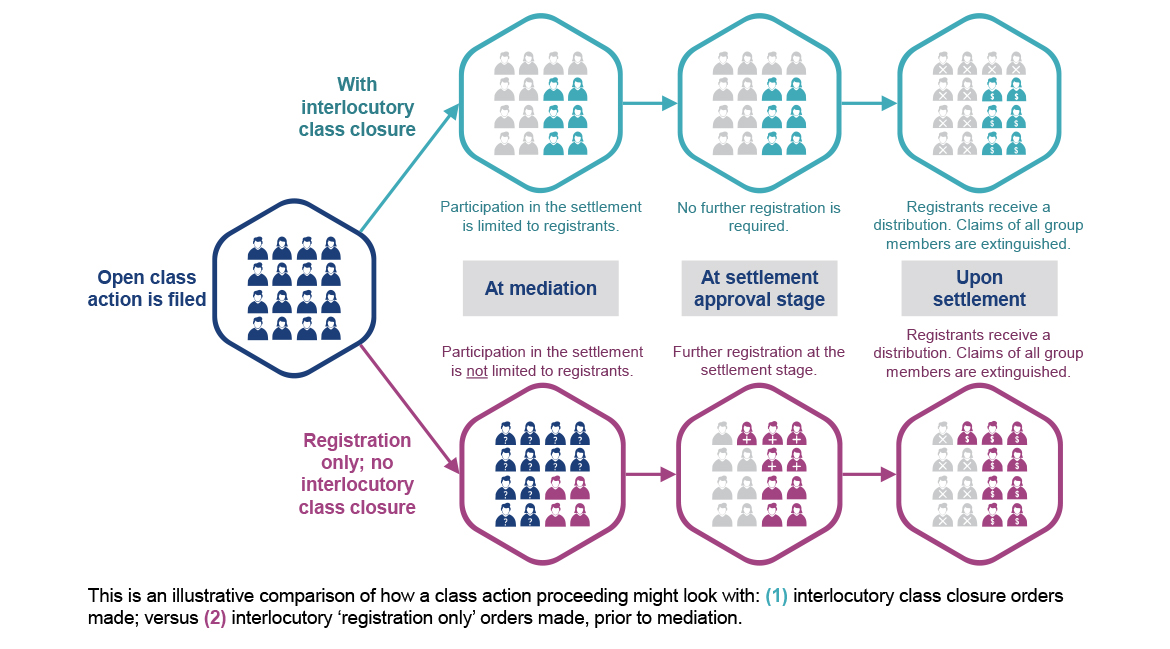Two decisions in Australia's courts have challenged the 'class closure' model in group actions. Bad news for parties trying to resolve disputes
Earlier this year, two decisions of the New South Wales Court of Appeal have challenged the appropriateness of what had been a standard class action procedural step known as “class closure”. This development will likely add to the complexities in resolving class action litigation, particularly where there are numerous potential group members or where the claims of group members vary considerably.

Scroll to read more on these topics below
-
What is class closure?
-
Why is class closure important?
-
What has changed?
-
What are the potential implications of this development?
-
Future reform?
What is class closure?
Class closure orders require group members to register their claims (and provide claim information) in order to participate in any settlement, with consequences attaching to those who fail to register before a prescribed deadline.
Under this form of class closure, non-registering group members still remain as group members for all other purposes, including being able to participate in any judgment award and being bound by any judgment.
Class closure orders were historically made pursuant to court powers, including those conferred by section 33ZF of the Federal Court of Australia Act 1976 (Cth) (and its equivalent provisions in State class action regimes). Section 33ZF provides that the Court may make any order it thinks “appropriate or necessary to ensure that justice is done in the proceedings”. For class action proceedings brought in the Victorian Supreme Court, class closure orders were also made pursuant to section 33ZG of the Supreme Court of Victoria Act 1986 (Vic), a provision unique to the Victorian class action regime.
Why is class closure important?
By requiring group members to step forward and provide claim information, class closure allows both plaintiffs and defendants to have a better understanding of the total quantum of registered group members’ claims. It enables the settlement amount to be capped by reference to the number of registered group members, and provides the defendant with finality upon settlement of the class action (by extinguishing the non-registering group members’ claims).
Accordingly, class closure orders facilitated meaningful settlement discussions and were (until recently) viewed as appropriate to ensure justice is done in the proceeding.
What has changed?
Earlier this year, in two separate decisions, the New South Wales Court of Appeal held that:
- the Court does not have power to make class closure orders under section 183 of the Civil Procedure Act 2005 (NSW) (equivalent to section 33ZF), where the outcome is to effectively extinguish the claims of non-registering group members. In reaching this conclusion, the Court of Appeal held that it is still permissible for a court to make orders allowing group members to register their claim (i.e. registration only, with no consequences for not registering).
- the Court can make orders exhorting registration, but cannot approve a registration notice that includes a reference to the parties’ intention to apply in the future for orders extinguishing the claims of non-registering group members if settlement occurs.
The Court of Appeal left open the possibility of class closure orders at the settlement stage, which would be made under different legislative sources of power.
As these decisions reflect the interpretation of effectively uniform legislation by an intermediate appellate court, this approach will likely be followed in other class actions jurisdictions with the same provisions.
What are the potential implications of this development?
- Increased challenges in settlement discussions
Class closure orders enable the parties to have certainty over a key aspect in calculating quantum, namely the level of participation by group members (in terms of number of group members and the particulars of loss). This is particularly significant in class actions where the size of the class is large, or group members are difficult to identify or locate, or the losses of group members are individualised. Class closure orders allow the parties to negotiate a settlement amount capped to the claims of registered group members.
A potential technique available to the parties to partially bridge the gap is to seek “registration without consequence” orders. This would have the effect of providing some information to the parties, enabling them to: (i) determine the base level of participation; and (ii) make more informed assumptions about future participants. In this way, it facilitates settlement, although not as perfectly and completely as class closure orders.
- Potential rise of process settlements
We may see more process-style class action settlements, whereby settlements are structured by reference to payments of a designated amount to group members who meet a particular description or satisfy a specific loss criteria (e.g. parties agree to a tiered structure of categories of loss). These settlements could be subject to a global sum cap or staggered caps depending on the level of participation. Process settlements or complex settlement structures may be more susceptible to challenge at the settlement approval stage.
- Potential inconsistency across different class action jurisdictions
The Victorian Supreme Court arguably has the power to make class closure orders. Historically, that Court made class closure orders by reference to section 33ZG, which does not have a counterpart in the NSW or Federal class action regimes. This is unlikely to be a definitive factor for class action plaintiffs when considering which court to commence a class action claim. However, when coupled with the recent introduction of contingency fees, the jurisprudence in that jurisdiction may significantly evolve in a direction that is different to that of the other state courts and the Federal Court.
Future reform?
The class action landscape has been the subject of significant scrutiny in 2020, and, prior to the decisions referred to above, class closure was specifically identified by the Australian Law Reform Commission (ALRC) as a potential area for legislative reform. The ALRC accepted the utility of class closure orders and recommended that the court’s practice and procedure include express guidance as to when class closure orders (and ancillary orders) may be made.
As part of the Parliamentary Inquiry into Litigation Funding and the Regulation of the Class Action Industry, Herbert Smith Freehills has submitted that there should be a legislative amendment to permit courts to make class closure orders for the benefit of the parties in obtaining clarity and finality in class action settlements. The Inquiry is due to report by 7 December 2020.
Key contacts
Legal Notice
The contents of this publication are for reference purposes only and may not be current as at the date of accessing this publication. They do not constitute legal advice and should not be relied upon as such. Specific legal advice about your specific circumstances should always be sought separately before taking any action based on this publication.
© Herbert Smith Freehills 2024


